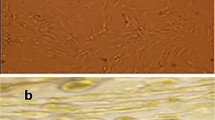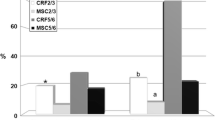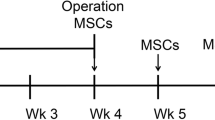Abstract
Chronic aristolochic acid (AA) nephropathy (CAAN) caused by intake of AA-containing herbs is difficult to treat. We evaluated the therapeutic effect of bone marrow (BM) mesenchymal stem cells (MSCs) on a rat model of CAAN. Female Wistar rats were fed with decoction of Caulis Aristolochia manshuriensis by intragastric administration. MSCs were prepared from BM of male Wistar rats and injected into female CAAN rats through tail vein. Body weight, renal function, and urinary excretion of these CAAN rats were monitored before killing at the end of the 20th week. Blood, urine, and tissue samples were collected from experimental (MSC and non-MSC) and normal control groups. All animals developed renal fibrosis after 12 weeks of intake of AA-containing decoction. Fibrosis in the MSC groups was significantly reduced as examined with light and electron microscopy. Blood urea nitrogen, serum creatinine, and urine protein levels were significantly reduced and hemoglobin levels were improved in the MSC group as compared with the non-MSC group (p < 0.01). The expression of TGF-β1 mRNA and protein was reduced but hepatic growth factor (HGF) was increased in the MSC group compared with the non-MSC group, but still higher than the normal control level as measured by immunochemical, RT-PCR, and western blotting assays (p < 0.01). The renal fibrosis of CAAN could be protected by isogenic MSC transplantation, probably via upregulation of HGF and downregulation of TGF-β1.







Similar content being viewed by others
Abbreviations
- CAAN:
-
Chronic aristolochic acid nephropathy
- AA:
-
Aristolochic acid
- MSCs:
-
Mesenchymal stem cells
- TGF-β1:
-
Transforming growth factor
- HGF:
-
Hepatocyte growth factor
- RP-HPLC:
-
Reversed-phase high-performance liquid chromatography
- IOD:
-
Integrated optical density
- TIMP-1:
-
Metalloproteinase-1
References
Vanherweghem JL, Depierreux M, Tielemans C et al (1993) Rapidly progressive interstitial renal fibrosis in young women: association with slimming regimen including Chinese herbs. Lancet 341:387–391
Nortier JL, Martinez MC, Schmeiser HH, Arlt VM, Bieler CA, Petein M, Depierreux MF, De Pauw L, Abramowicz D, Vereerstraeten P, Vanherweghem JL (2000) Urothelial carcinoma associated with the use of a Chinese herb (Aristolochia fangchi). N Engl J Med 342:1686–1692
Tanaka A, Nishida R, Maeda K, Sugawara A, Kuwahara T (2000) Chinese herb nephropathy in Japan presents adult-onset Fanconi syndrome: could different components of aristolochic acids cause a different type of Chinese herb nephropathy? Clin Nephrol 53:301–306
Yang CS, Lin CH, Chang SH, Hsu HC (2000) Rapidly progressive fibrosing interstitial nephritis associated with Chinese herbal drugs. Am J Kidney Dis 35:313–318
Grollman AP, Jelakovic B (2007) Role of environmental toxins in endemic (Balkan) nephropathy. October 2006, Zagreb, Croatia. J Am Soc Nephrol 18:2817–2823
de Jonge H, Vanrenterghem Y (2008) Aristolochic acid: the common culprit of Chinese herbs nephropathy and Balkan endemic nephropathy. Nephrol Dial Transplant 23:39–41
Lai MN, Lai JN, Chen PC, Hsieh SC, Hu FC, Wang JD (2010) Risks of kidney failure associated with consumption of herbal products containing Mu Tong or Fangchi: a population-based case–control study. Am J Kidney Dis 55:507–518
Vanherweghem JL, Abramowicz D, Tielemans C, Depierreux M (1996) Effects of steroids on the progression of renal failure in chronic interstitial renal fibrosis: a pilot study in Chinese herbs nephropathy. Am J Kidney Dis 27:209–215
Wang JS, Shum-Tim D, Galipeau J, Chedrawy E, Eliopoulos N, Chiu RC (2000) Marrow stromal cells for cellular cardiomyoplasty: feasibility and potential clinical advantages. J Thorac Cardiovasc Surg 120:999–1005
Tang YL, Tang Y, Zhang YC, Qian K, Shen L, Phillips MI (2005) Improved graft mesenchymal stem cell survival in ischemic heart with a hypoxia-regulated heme oxygenase-1 vector. J Am Coll Cardiol 46:1339–1350
Reinders ME, Fibbe WE, Rabelink TJ (2010) Multipotent mesenchymal stromal cell therapy in renal disease and kidney transplantation. Nephrol Dial Transplant 25:17–24
Kunter U, Rong S, Djuric Z, Boor P, Muller-Newen G, Yu D, Floege J (2006) Transplanted mesenchymal stem cells accelerate glomerular healing in experimental glomerulonephritis. J Am Soc Nephrol 17:2202–2212
Nakagawa T, Lan HY, Glushakova O, Zhu HJ, Kang DH, Schreiner GF, Bottinger EP, Johnson RJ, Sautin YY (2005) Role of ERK1/2 and p38 mitogen-activated protein kinases in the regulation of thrombospondin-1 by TGF-beta1 in rat proximal tubular cells and mouse fibroblasts. J Am Soc Nephrol 16:899–904
Li Y, Spataro BC, Yang J, Dai C, Liu Y (2005) 1,25-Dihydroxyvitamin D inhibits renal interstitial myofibroblast activation by inducing hepatocyte growth factor expression. Kidney Int 68:1500–1510
Pittenger MF, Mackay AM, Beck SC, Jaiswal RK, Douglas R, Mosca JD, Moorman MA, Simonetti DW, Craig S, Marshak DR (1999) Multilineage potential of adult human mesenchymal stem cells. Science 284:143–147
Sun D, Feng J, Sun L, Jin T, Wang Z, Ma J, Wang L (2006) Mechanism of early anemia in rat model of chronic aristolochic acid nephropathy. Chin J Nephrol 22:237–242
Singaravelu K, Padanilam BJ (2009) In vitro differentiation of MSC into cells with a renal tubular epithelial-like phenotype. Ren Fail 31:492–502
Yang L, Li X, Wang H (2007) Possible mechanisms explaining the tendency towards interstitial fibrosis in aristolochic acid-induced acute tubular necrosis. Nephrol Dial Transplant 22:445–456
Li JH, Zhu HJ, Huang XR, Lai KN, Johnson RJ, Lan HY (2002) Smad7 inhibits fibrotic effect of TGF-Beta on renal tubular epithelial cells by blocking Smad2 activation. J Am Soc Nephrol 13:1464–1472
Zhou L, Fu P, Huang XR, Liu F, Chung AC, Lai KN, Lan HY (2010) Mechanism of chronic aristolochic acid nephropathy: role of Smad3. Am J Physiol Renal Physiol 298:F1006–F1017
Vargas GA, Hoeflich A, Jehle PM (2000) Hepatocyte growth factor in renal failure: promise and reality. Kidney Int 57:1426–1436
Yang J, Liu Y (2003) Delayed administration of hepatocyte growth factor reduces renal fibrosis in obstructive nephropathy. Am J Physiol Renal Physiol 284:F349–F357
Mizuno S, Matsumoto K, Kurosawa T, Mizuno-Horikawa Y, Nakamura T (2000) Reciprocal balance of hepatocyte growth factor and transforming growth factor-beta 1 in renal fibrosis in mice. Kidney Int 57:937–948
Acknowledgments
This work was supported by Liaoning Province Department of education scientific research project (No: L2010568).
Conflict of interest
None declared.
Author information
Authors and Affiliations
Corresponding author
Rights and permissions
About this article
Cite this article
Li, W., Jiang, H. & Feng, JM. Isogenic mesenchymal stem cells transplantation improves a rat model of chronic aristolochic acid nephropathy via upregulation of hepatic growth factor and downregulation of transforming growth factor β1. Mol Cell Biochem 368, 137–145 (2012). https://doi.org/10.1007/s11010-012-1352-5
Received:
Accepted:
Published:
Issue Date:
DOI: https://doi.org/10.1007/s11010-012-1352-5




